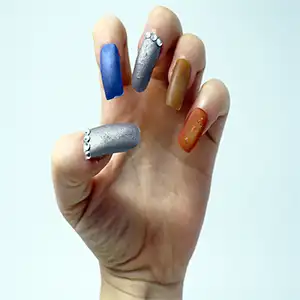
Biodegradable fingernails? Yes, and you can make them at home and reuse
Picture this: you’re at home, relaxing, and giving yourself a fresh manicure with bright pink nails that shimmer with sparkles or are maybe even embedded with a computer chip.
When you’re done showing them off for the week, you melt them down and start over – no waste, no guilt. That’s the idea behind Bio-e-Nails.
A team of researchers at the University of Colorado Boulder’s ATLAS Institute has created a biodegradable, customizable press-on nail that could redefine how we think about beauty and sustainability.
The nails are made from simple, natural materials, like algae and shellfish shells, and are easy to create at home using basic craft tools and ingredients from your local store.
A new kind of nail
Bio-e-Nails are colorful, fun, and designed to be reused.
Whether you love long, glittery nails or short, vibrant ones, these can be made to match your exact style – and then remade again when you’re ready for a change.
“With Bio-e-Nails, there can be a second life, a third life, a fourth life,” said Lázaro Vásquez, a doctoral student at ATLAS.
“The material can be remelted and reshaped into new objects. You can make a new nail, for sure, but also a coaster for your coffee cup.”
Why biodegradable nails are a big deal
Bio-e-Nails were first presented at the 2025 Tangible, Embedded and Embodied Interaction (TEI) conference in France.
The concept grew from a class project into a research collaboration that brought together students and faculty interested in sustainable design.
“Sustainability goes beyond merely replacing plastic with a substitute material,” said Mirela Alistar, assistant professor at ATLAS and the Department of Computer Science.
“Both the designer and the user also need to change their mindset. That type of change, which considers the entire lifecycle of the wearable, is what we are tackling through our research in the Living Matter Lab.”
Nails with a purpose
For many, visiting a nail salon is more than just pampering – it’s self-expression.
“[Nails] can be a reflection of your personality,” Vásquez said. “They represent something that comes from you.”
But traditional nail products often contain chemicals like methyl methacrylate, which can be harmful to both workers and clients.
The booming $700 million press-on nail industry also generates a surprising amount of plastic waste.
Alistar pointed out the hidden cost of all this beauty: “We’re not used to thinking of nails as a waste material because they’re so small, but they add up.”
How to make biodegradable nails at home
To make Bio-e-Nails, you start with one of two key ingredients: agar or chitosan.
Agar, derived from algae, is often used as a vegan substitute for gelatin. Chitosan, on the other hand, comes from seashells and is widely used in supplements.
If you’re using chitosan, the process is simple. Mix it with vinegar and water, heat and cool it in a water bath, and pour it into a mold shaped like your favorite nail.
After a couple of days, peel the film off, trim the edges, and you’re ready. The agar version is equally easy.
Then, it’s time to get creative.
Fully custom and even smart
You can mix in food coloring for vibrant shades, or add glitter and tiny crystals to match your mood or outfit.
The nails can even go high-tech. The team experimented with embedding small computer chips into the nails.
These can be programmed to interact with your smartphone, like showing your emergency contact or pulling up directions when tapped.
Don’t toss them, reshape and reuse them
Bio-e-Nails are meant for short-term wear – perfect for a party or weekend event. And when you’re done? Don’t toss them.
Reuse the material, reshape it into your next look, or even turn it into something completely different.
“Composting should be the last alternative. We want to keep the materials in use as long as we can,” explained Vásquez.
“In biodesign, it’s not just about replacing traditional materials with biodegradable ones – it’s about rethinking the entire design process, considering the life cycle of the material and eventual products, and how they can stay in circulation and be transformed before they ever return to nature.”
What happens next?
With Bio-e-Nails, beauty isn’t just skin deep – it’s a way to rethink how we care for ourselves and the planet. From your fingertips to your compost bin – or your next set of nails – it’s all connected.
Details of the study were presented at the 2025 Tangible, Embedded and Embodied Interaction Conference.
Watch a video demonstration by clicking here…
The full study is published here…
—–
Like what you read? Subscribe to our newsletter for engaging articles, exclusive content, and the latest updates.
Check us out on EarthSnap, a free app brought to you by Eric Ralls and Earth.com.
—–













